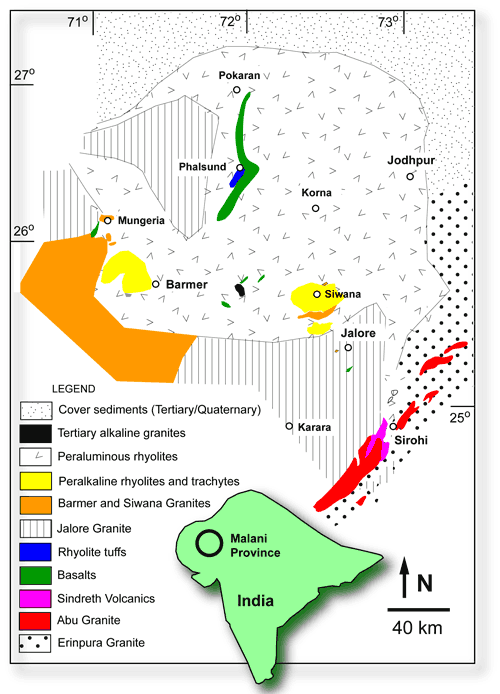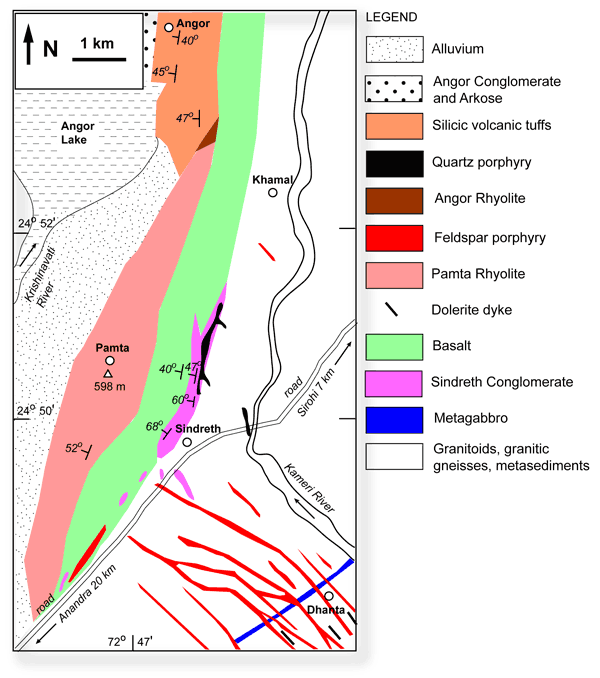 |
 |
Neoproterozoic
Malani Magmatism, northwestern Indian shield:
Not a plume product
|
|
Kamal
K. Sharma
Department
of Geology, Government Postgraduate College, Sirohi
(Rajasthan) 307001 India
sharmasirohi@yahoo.com
 Click here to
download a PDF version of this webpage Click here to
download a PDF version of this webpage
|
Abstract
The Neoproterozoic (~750 Ma) Malani magmatic province
occupies a large area (~50,000 km2) of
the northwestern Indian shield. It is dominantly made
up of felsic (rhyolitic) lava flows and granitic plutons,
with subordinate mafic lavas, and felsic and mafic
dykes. The Malani province represents a large, intraplate,
anorogenic felsic event, which is why some workers
have ascribed it to a mantle plume. Geological observations
indicate, however, that Malani volcanism occurred
along parallel crustal fractures that developed as
a result of extensional tectonics. This suggests an
intra-cratonic rift setting, and a deep mantle plume
is neither necessary nor viable.
The geology
Malani magmatism represents the largest
single felsic magmatic event to have occurred in India,
and is spread over the Aravalli craton, one of several
ancient continental nuclei of which India is built.
The Malani rocks form linear hills, tors, inselbegs,
rings and hammocks in the Rajasthan and Haryana regions
of northwestern India, and are covered in places by
younger sediments, including wind-blown sands from the
Thar Desert (Figure 1). Malani magmatism has been divided
into three phases. The
first phase comprises bimodal volcanism,
with initial basic lava flows followed by rhyolites,
ignimbrites and ultrapotassic rhyolites. The eruptions
were predominantly subaerial, but aqueous conditions
existed in a few places, as is indicated by conglomerate
and arkose beds underlying the lavas, pillow basalts,
and the development of sedimentary features in the volcanics.
The second phase
is characterised by plutons and bosses of granites.
The third phase
involved the intrusion of basic and felsic dykes along
the rift margin (Kochhar et al., 1995). These
dykes developed along secondary rift fractures transverse
to the linear basins (Figure 2). There is a general
consensus based on, for example, Rb-Sr isotope data
(e.g., Crawford, 1975; Choudhary et al.,
1984) that the Malani magmatism occurred at ~750 Ma
and had a relatively short duration of about 20 m.y.,
though Rathore et al. (1999) have argued for
a duration of 100 m.y., from 780 Ma to 680 Ma.

Figure 1: Geological sketch map
of western Rajasthan showing the area occupied by the
Malani magmatic rocks (modified from Bhushan, 1995).
Click on figure for enlargement.
The subduction model
Sinha-Roy & Mohanty (1988) have considered
Malani magmatism to be a result of low-angle subduction
of the Delhi oceanic\transitional crust below the
western Rajasthan/Aravalli craton under an extensional
tectonic regime. Bhushan & Chittora (2000)
rejected the plate subduction model, however, after
considering the setting at Kankani (Jodhpur), where
the Malani lavas overlie the basement with a well-defined
unconformity in between.
The hotspot model
Kochhar (1984) attributed Malani magmatism
to hotspot activity. He suggested that there were
at least two abortive attempts by the Indian lithosphere
to rift in Proterozoic time, one at 1,500-1,100 Ma,
and the other at 750 Ma, related to the Malani magmatism.
He further argued that there was no movement of the
Indian plate relative to the hotspot between 1,500
Ma and 750 Ma. He proposed a Neoproterozoic supercontinent
called the Malani Supercontinent and considered the
Malani event to be part of the Pan-African thermal
event. Bhushan (1999, 2000), Raval
(2000) and Roy (2001) also supported Kochhar’s
hotspot model for the anorogenic Malani magmatism.
The hotspot model questioned
Pareek (1984) and Srivastava (1988)
described the metasediments of the Aravalli Suprgroup
(Archean-early Proterozoic) in western Rajasthan.
Bhushan (2000) proposed that basement rocks
of the Banded Gneissic Complex (Achaean) underlie
the Malani rocks. Geological studies indicate considerable
rotation of the Malani tectonic grain, observed, for
example, in the Sindreth region (Sharma,
1996). The linear disposition of conglomerates and
other sedimentary features in close association with
the Malani volcanics (Figure 2) indicates lineament-controlled
igneous activity.

Figure 2: Geological map of the
Sindreth region showing the linear rift basin structural
setting of the Malani rocks (from Sharma, 1996).
Pareek (1984) considered that the main trend
of Malani outpouring is fissure-controlled and there
is a relationship between volcanism and tectonic lineaments.
Srivastava (1988) also proposed that weak
lines developed parallel to the Aravalli mountain
range during its uplift in late Proterozoic time,
through which the Malani lavas poured. The crustal
fractures indicate an intra-cratonic rift setting
with an extensional tectonic regime. These N-S trending
subparallel rifts are separated by segments of the
basement rocks, visible at Undwaria, Sindreth, Bambholai,
Miniari and elsewhere. The linear outcrop pattern
of Undwaria-Sindreth-Miniari is the best example of
this (Figure 2). The bimodal Malani volcanism took
place in shallow and narrow basins, and the volcanics
show angular relationships with the underlying Sirohi
Group and other basement rocks. The plutonic activity
is marked by emplacement of granites, e.g., at Jalore,
Siwana, Isra, and elsewhere.
The Malani felsic volcanics were produced by crustal
melting. If there was any contribution from the mantle,
it would be the basalts and the ultramafic cumulate
rocks contained in the related granites (e.g., at
Jalore, Isra, and Siwana) After the close of the orogenic
cycles in the Aravalli craton, and prior to the Malani
event, the crust was stable for a long time (Sharma
& Roy, 1997). The prolonged stability and
thermal insulation of this crust would have led to
accumulation of heat, which then resulted in an extensional
tectonic regime and crustal melting. Thus, the dominantly
felsic Malani magmatism, though intraplate and anorogenic,
is not consistent with the deep mantle plume/hotspot
model.
|
- Bhushan, S. K. (1995) Late Proterozoic continental
growth: implications from geochemistry of acid magmatic
events of west Indian craton, Rajasthan. Geol.
Soc. Ind. Mem. 34, 339-355.
- Bhushan, S. K. (1999) Neoproterozoic magmatism in
Rajasthan. Proc. Seminar, Geology of Rajasthan:
Status and Perspective. Dept. Geology, Sukhadia
University, Udaipur, 101-110.
- Bhushan, S. K. (2000) Malani Rhyolite - a review.
Gondwana Res., 3, (1), 65-77.
- Bhushan, S. K. and Chittora, V. K. (2000) Flow stratigraphy
of Malani volcanics around Kankani, south of Jodhpur,
western Rajasthan. In: Gyani and Kataria (Eds.), Tectonomagmatism,
Geochemistry and Metamorphism of Pecambriam Terrains.
Dept. Geology, Sukhadia University, Udaipur, 97-108.
- Choudhary, A. K., Gopalan, K. and Sastry, C.A. (1984)
Present status of the geochronology of the Precambrian
rocks of Rajasthan. Tectonophysics, 105,
131-140.
- Crawford, A. R. (1975) Rb-Sr age determination for
the Mt. Abu granite and related rocks of Gujarat.
J. Geol. Soc. Ind., 16,
(1), p. 73
- Kochhar, N. (1984) Malani Igneous Suite: hot spot
magmatism and cratonisation of the northern part of
the Indian shield. J. Geol. Soc. Ind., 25,
155-161.
- Kochhar, N., 1996. A-type Malani magmatism, northwestern
peninsular India. In: Deb, M., Banerjee, D. M. (Eds.),
Proc. Seminar ‘Mineralization in the Western
Indian Craton’, Dept. Geology, Delhi University,
pp. 10-15.
- Kochhar, N., Dhar, S. and Sharma, R. (1995) Geochemistry
and tectonic significance of acid and basic dykes
associated with Jalor magmatism, west Rajasthan. Geol.
Soc. Ind. Mem. 33, 375-390.
- Pareek, H. S. (1984) Pre-Quaternary geology and
mineral resources of Northwestern Rajasthan. Geol.
Surv. Ind. Mem. 115, 95 pp.
- Rathore, S. S., Venkatesan, T. R. and Srivastava,
R. K. (1999) Rb-Sr isotope dating of Neoproterozoic
(Malani Group) magmatism from south-west Rajasthan,
India: evidence of younger Pan-African thermal event
from 40Ar-39Ar studies. Gondwana
Res., 2, 271-281.
- Raval, U. (2000) Physico-chemical response of cratons
and mobile belts to plate, plume and mixed-mode tectonics:
evidence from Indian Precambrian. In: Gyani and Kataria
(Eds.) Tectonomagmatism, Geochemistry and Metamorphism
of Pecambrian Terrains. Dept. Geology, Sukhadia
University, Udaipur, pp. 1-26.
- Roy, A. B. (2001) Neoproteozoic crustal evolution
of northwestern Indian shield: Implications on break-up
and assembly of supercontinents. Gondwana Res.,
4, (3), 289-306.
- Sharma, K. K. and Roy, A. B. (1997) Neoproterozoic
geology and evolution of the Trans-Aravalli crust.
Proc. Seminar, Precambrian ’97. Sukhadia
University, Udaipur, pp. 15-16.
- Sharma, K. K. (1996) Stratigraphy, structure
and tectonic evolution of the metasediments and associated
rocks of the Sirohi region. Ph.D. thesis, Sukhadia
University, Udaipur, 103 pp.
- Sinha-Roy, S. and Mohanty, M. (1988) Blueschist
facies metamorphism in the ophiolite melange of the
late Proterozoic Delhi old Belt, Rajsthan, India.
Precamb. Res., 42, 97-105.
- Srivastava, R. K., 1988. Magmatism in the Aravalli
mountain range and its environs. Geol. Soc. Ind.
Mem. 7, 77- 94.
|
|
|
